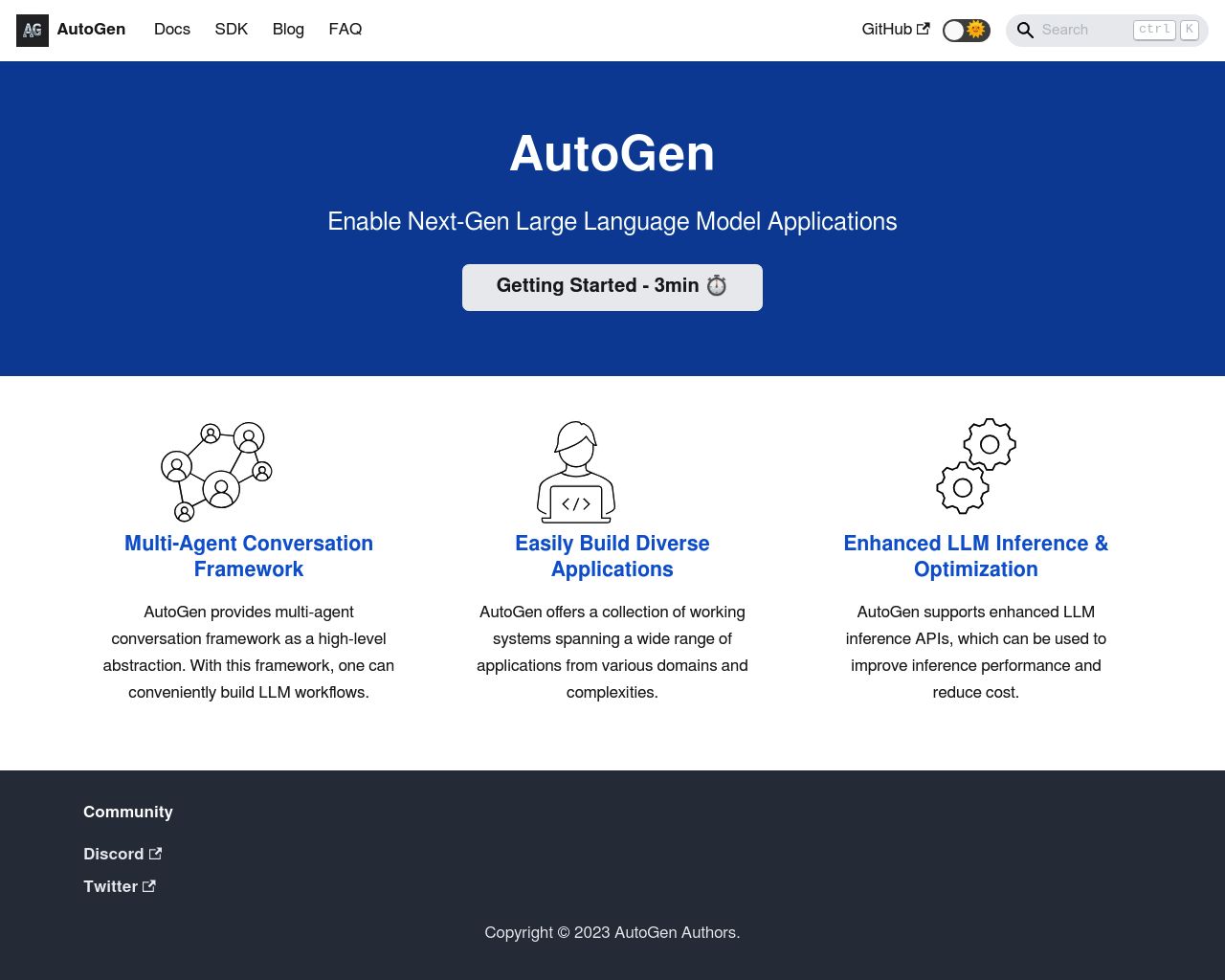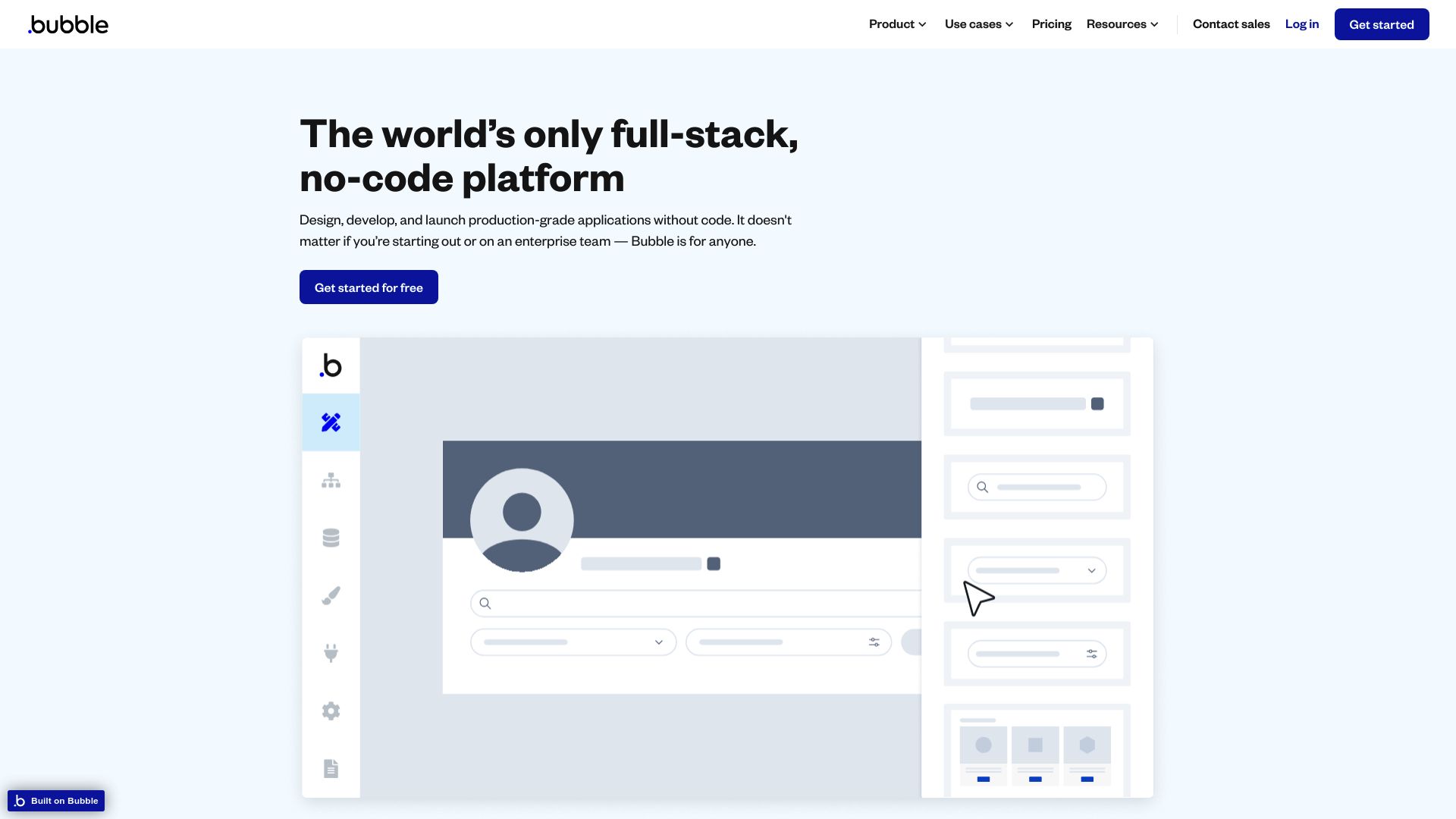AutoGen vs. Bubble: Feature Comparison
Artificial intelligence redefines software development, offering powerful tools for both technical experts and non-coders. Our comparison of AutoGen, Bubble, and SmythOS reveals distinct approaches to AI integration and application building. AutoGen empowers developers with sophisticated multi-agent systems, while Bubble’s no-code platform simplifies web app creation. SmythOS emerges as a versatile solution, combining advanced AI capabilities with user-friendly interfaces. This review explores each platform’s strengths in agent creation, ease of use, and enterprise readiness, guiding readers to choose the ideal tool for their AI development needs.
AutoGen Overview
AutoGen empowers developers to build sophisticated Large Language Model (LLM) applications through multi-agent conversations. This open-source framework orchestrates customizable AI agents that collaborate to tackle complex tasks autonomously or with human input.


AutoGen maximizes LLM performance with enhanced inference capabilities, including tuning, caching, and error handling. The platform supports both fully autonomous operations and human-in-the-loop workflows, adapting to diverse application needs from code generation to complex problem-solving in group chats.
AutoGen empowers developers to build sophisticated Large Language Model (LLM) applications through multi-agent conversations.
Developers benefit from AutoGen’s debugging tools and logging functionalities, essential for optimizing LLM-based systems. The framework also includes EcoOptiGen, a cost-effective technique for tuning large language models, highlighting its focus on efficiency.
While AutoGen offers powerful capabilities for LLM application development, it lacks a visual builder or no-code editor, requiring coding expertise for setup and customization. This may limit accessibility for non-technical users seeking to create AI agents quickly. Additionally, the framework does not mention specific features for data encryption or IP control, which could be concerns for enterprise users with strict security requirements.
Bubble Overview
Bubble empowers users to create web applications without coding. This no-code platform features a drag-and-drop interface, making app development accessible to non-technical users and experienced developers alike.


Bubble’s strengths lie in its visual development environment and robust integration capabilities. Users can build complex, interactive web applications by connecting pre-built elements and defining workflows visually. The platform supports integration with popular AI services, including OpenAI’s GPT models, allowing developers to incorporate advanced AI functionalities into their applications.
Bubble empowers users to create web applications without coding… making app development accessible to non-technical users and experienced developers alike.
Scalability and security stand out as key features of Bubble. Built on Amazon Web Services, the platform ensures a robust infrastructure capable of handling enterprise-level applications. Bubble offers GDPR compliance and SOC 2 Type II certification, addressing critical security concerns for businesses of all sizes.
While Bubble excels in web application development, it lacks some features found in dedicated AI agent builders. The platform does not offer native support for creating autonomous AI agents or advanced features like multi-agent collaboration. Users looking to build complex AI systems may find Bubble’s AI capabilities limited compared to specialized AI development platforms.
Bubble’s marketplace of templates and plugins enhances its versatility, offering pre-made solutions for common application types and integrations. This ecosystem allows developers to extend Bubble’s functionality and accelerate development timelines. However, users seeking deep customization of AI behaviors or advanced machine learning capabilities may need to look elsewhere or combine Bubble with other specialized tools.
Feature Comparison
AutoGen and Bubble offer distinct approaches to software development, with notable differences in their core components and security features. AutoGen excels in creating sophisticated AI agents capable of autonomous operations and multi-agent collaboration. Its framework supports enhanced Large Language Model (LLM) inference, customizable agents, and debugging tools essential for optimizing LLM-based systems. AutoGen’s strength lies in its ability to facilitate complex problem-solving through agent interactions, making it ideal for developers seeking to build advanced AI applications.
Bubble, in contrast, focuses on no-code web application development. Its visual builder and drag-and-drop interface make it accessible to users without programming expertise. While Bubble supports integration with AI services like OpenAI’s GPT models, it lacks native capabilities for creating autonomous AI agents or facilitating multi-agent collaboration. Bubble’s security features, including GDPR compliance and SOC 2 Type II certification, cater to enterprise-level requirements, surpassing AutoGen’s limited documentation on data encryption and IP control.
The platforms diverge significantly in their core components. AutoGen provides tools for enhancing LLM performance, including tuning and caching, which are absent in Bubble. Conversely, Bubble offers a marketplace of templates and plugins, extending its functionality for rapid application development. This ecosystem approach is not present in AutoGen, which requires more technical expertise to extend its capabilities. While both platforms support API integrations, Bubble’s no-code approach simplifies this process for non-technical users, contrasting with AutoGen’s more code-centric method of API utilization.
Feature Comparison Table
| AutoGen | Bubble | SmythOS | |
|---|---|---|---|
| CORE FEATURES | |||
| Visual Builder | ❌ | ✅ | ✅ |
| No-Code Options | ❌ | ✅ | ✅ |
| Memory & Context | ✅ | ❌ | ✅ |
| Autonomous Agents | ✅ | ❌ | ✅ |
| Explainability & Transparency | ✅ | ❌ | ✅ |
| Multimodal | ✅ | ❌ | ✅ |
| Multi-Agent Collaboration | ✅ | ❌ | ✅ |
| Bulk Work | ✅ | ❌ | ✅ |
| Agent Work Scheduler | ❌ | ❌ | ✅ |
| SECURITY | |||
| Constrained Alignment | ❌ | ❌ | ✅ |
| IP Control | ❌ | ❌ | ✅ |
| COMPONENTS | |||
| Huggingface AIs | ✅ | ❌ | ✅ |
| Classifiers | ✅ | ❌ | ✅ |
| Data Lakes | ❌ | ✅ | ✅ |
| DEPLOYMENT OPTIONS (EMBODIMENTS) | |||
| Deploy as API | ✅ | ❌ | ✅ |
| Staging Domains | ❌ | ✅ | ✅ |
| Production Domains | ❌ | ✅ | ✅ |
| Deploy as Scheduled Agent | ❌ | ❌ | ✅ |
| DATA LAKE SUPPORT | |||
| Hosted Vector Database | ❌ | ❌ | ✅ |
| Sitemap Crawler | ❌ | ❌ | ✅ |
| YouTube Transcript Crawler | ❌ | ❌ | ✅ |
| URL Crawler | ✅ | ❌ | ✅ |
Conclusion
AutoGen and Bubble offer distinct approaches to software development, each with unique strengths. AutoGen excels in creating sophisticated AI agents for complex problem-solving, while Bubble provides an accessible no-code platform for web application development. However, SmythOS emerges as the superior choice, combining the best of both worlds and offering additional features that set it apart.
SmythOS’s drag-and-drop interface rivals Bubble’s ease of use while providing advanced AI capabilities that surpass AutoGen’s offerings. Our platform supports multi-agent collaboration, autonomous operations, and seamless integration with over 300,000 APIs and services. Unlike AutoGen, SmythOS requires no coding expertise, making it accessible to both technical and non-technical users.
Security and scalability are paramount in SmythOS. We offer robust data encryption, OAuth support, and IP control features, addressing enterprise-level security concerns more comprehensively than both AutoGen and Bubble. Our platform’s ability to deploy AI agents across various environments, from APIs to chatbots and scheduled tasks, provides unmatched versatility.
For those looking to harness the power of AI without sacrificing ease of use or scalability, SmythOS is the clear choice. We invite you to explore our diverse range of AI-powered agent templates and experience the future of AI development. Create a free SmythOS account today and join the AI revolution – no credit card required, with a 30-day money-back guarantee.
Last updated:
Disclaimer: The information presented in this article is for general informational purposes only and is provided as is. While we strive to keep the content up-to-date and accurate, we make no representations or warranties of any kind, express or implied, about the completeness, accuracy, reliability, suitability, or availability of the information contained in this article.
Any reliance you place on such information is strictly at your own risk. We reserve the right to make additions, deletions, or modifications to the contents of this article at any time without prior notice.
In no event will we be liable for any loss or damage including without limitation, indirect or consequential loss or damage, or any loss or damage whatsoever arising from loss of data, profits, or any other loss not specified herein arising out of, or in connection with, the use of this article.
Despite our best efforts, this article may contain oversights, errors, or omissions. If you notice any inaccuracies or have concerns about the content, please report them through our content feedback form. Your input helps us maintain the quality and reliability of our information.
